- Insuring agriculture in times of climate change
- Scientific evidence has established that climate change is accelerating the frequency and intensity of extreme weather events like droughts, floods, unseasonal rainfall and extreme temperatures.

- Africa-Asia Conclave on Loss and Damage due to Climate Change: Instituting a Global Agricultural Insurance Programme as a Risk Sharing and Transfer Mechanism for Developing Countries

- Lived Anomaly: How to Enable Farmers in India to Cope with Extreme Weather Events
- An assessment report on the impacts of extreme weather events on the agricultural sector and lacunae in existing crop-loss estimation, relief and compensation mechanism.

- Bonn climate talks off to an explosive start
- As opposed to negotiating with developed countries, day 1 seemed to be all about developing countries versus the co-chairs
.jpg)
- Capitan America – US climate goals: a reckoning
- The perception is that after peaking in 2005, US total greenhouse gas emissions have been reducing. Not true. Compared to 1990 levels, greenhouse gas emissions are up 6 per cent. 1990-2013

- Climate organizations call for renewed efforts to communicate climate change knowledge and spur action
- This year marked the 10-year anniversary of Hurricane Katrina, which swept through America’s Gulf coast, wreaking a staggering USD 108 billion in damage and killing more than 1,800 people.

- First draft of new climate change agreement presented to Governments
- Work towards a new universal climate change agreement was today strengthened through the issuance of the first comprehensive draft of the agreement.

- Krishi Sutra
- As 2014, the year of farmer-producer organizations , comes to an end, check out the success stories of a few such organisations that showcase collective efforts to battle challenges like shrinking landholdings and climate change related extreme weather events

- Krishi Sutra
- As 2014, the year of farmer-producer organizations , comes to an end, check out the success stories of a few such organisations that showcase collective efforts to battle challenges like shrinking landholdings and climate change related extreme weather events

- Refugees | One person is displaced every second by disasters
- In 2014, 17.5 million people were forced to flee their homes by disasters brought on by weather-related hazards such as floods and storms, and 1.7 million by geophysical hazards such as earthquakes - See more at: http://indiaenvironmentportal.org.in/media/iep/infographics/displace2015/refugees.html#sthash.ZMYUEXXt.dpuf

- Flood fury 2015
- Flash flooding triggered by torrential rains has killed 71 people in Gujarat, as annual monsoon season hits the country. Track the latest updates as floods threaten and disrupt normal life

- Christiana Figueres: Why business matters at COP
- Christiana Figueres has been the executive secretary of the United Nations Framework Convention on Climate Change (UNFCCC)

- India's killer heat wave
- Nearly 2,000 people in the country have lost their lives to heat wave this summer. As these numbers continue to soar and experts debate on what lies ahead, a look at possible answers to questions that might be troubling most of us

- The Earth Statement
- The Earth Statement, written by 17 members of the Earth League, clarifies in 8 essential points what the international climate agreement at Paris 2015, COP 21, should achieve to provide the world with a decent chance of avoiding dangerous climate change

- Questions and answers on the European Commission Communication: The Paris Protocol – A blueprint for tackling global climate change beyond 2020

- The costs of climate change impacts for India: a preliminary analysis
- India has emphasised inclusion of adaptation as a part of Intended Nationally Determined Contributions (INDC)

- Natural disasters will soon cost the world $314 billion annually: UN
- The UN Office for Disaster Risk Reduction (UNISDR), in this report has said that as much as US $314 billion will have to be spent every year to meet annual average losses from just earthquakes, tsunamis, tropical cyclones and river flooding.

- 160 years of changing global emissions
- The Climate Analysis Indicators Tool (CAIT 2.0), developed and maintained by the World Resources Institute, provides a comprehensive and comparable database of greenhouse gas (GHG) emissions data and other climate-relevant indicators

- The European environment- state and outlook 2015: synthesis report
- Europe's environment and climate policies have delivered substantial benefits, improving the environment and quality of life, while driving innovation, job creation and growth
.jpg)
- The human cost of natural disasters: a global perspective
- This report presents data about natural disasters impacts (human and economic) at world scale for the last 20 years.
.jpg)
- Disaster-related displacement risk: measuring the risk and addressing its drivers
- The report forecasts an increased risk of global displacement caused by disasters, and calls for a stronger link between displacement and disaster risk reduction.

- Urban climate change resilience in action: lesson from projects in 10 ACCCRN cities
- This portfolio of projects provides a ‘first generation’ view of how a set of cities have interpreted building urban climate change resilience (UCCR) challenges

